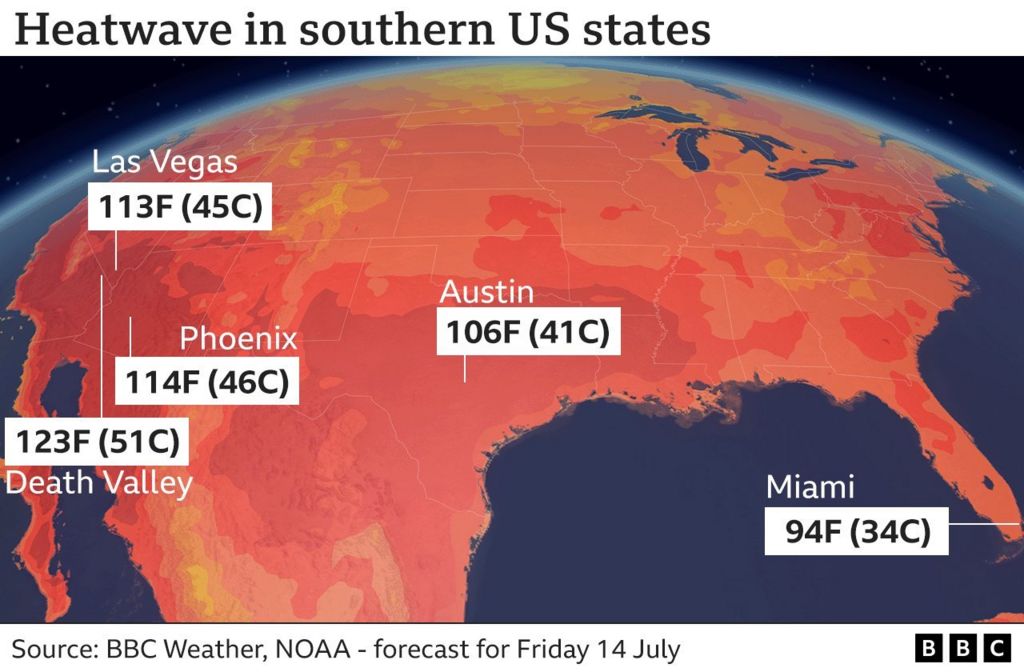A blistering US heatwave is forecast to intensify this weekend, with warnings issued across the south-west.
Heat advisories late on Friday affected at least 113 million Americans, from Florida to Texas to California, up to the north-western state of Washington.
Air conditioner use in Texas has topped the state’s previous record for power consumption as people try to keep cool.
Around 27 million people are forecast to experience temperatures over 110F (43C) in the coming days.
The heat is a result of an upper level ridge of high pressure, which typically brings with it warmer temperatures, the National Weather Service (NWS) said.
The agency added it is “one of the strongest” systems of its kind that the region has ever seen.
“The subtropical ridge responsible for this likely historic heatwave across the region is not showing signs of letting up anytime soon,” the NWS said.
About 700 people are estimated to die each year from heat-related causes in the US, according to the Centers for Disease Control and Prevention.
Saturday will also be exceptionally hot, with daytime highs forecast to hit up to 115F (46C) in some areas. The scorching heat is expected to linger until next week.

Phoenix is on course to break its longest hot spell record with the forecast for the next five days expected to hit or exceed 110F (43C).
The all-time record is 18 days and the city has already seen 15 days of 110F temperatures.
Las Vegas may match its all-time high of 117F (47C) in the next few days, while Death Valley, California – one of the hottest places on Earth – could surpass its official all-time high temperature of 130F (54C).
The NWS in Las Vegas warned locals, who might think they can handle the temperatures, that this is “not your typical desert heat”.
They tweeted: “‘It’s the desert, of course its hot’- This is a DANGEROUS mind set! This heatwave is NOT typical desert heat due to its long duration, extreme daytime temperatures, & warm nights. Everyone needs to take this heat seriously, including those who live in the desert.”
Parts of the south-western US have already grappled with intensely hot temperatures over the past week. In El Paso, Texas, temperatures have been in the triple-digits Fahrenheit for 27 consecutive days.
Parks, museums, zoos and businesses have either announced closures or shortened hours because of the extreme heat.
The Bison Café in Quitaque, Texas, announced shorter hours, saying the scorching temperatures were making the kitchen “very uncomfortable” for cooks.
Hospitals were also seeing heat-related admissions.
“We’re getting a lot of heat-related illness now, a lot of dehydration, heat exhaustion,” said Dr Ashkan Morim, who works in the emergency room at Dignity Health Siena Hospital, outside of Las Vegas.
Overnight temperatures were expected to remain “abnormally warm” in some areas, offering little night-time relief from the heat.
Demand for power in Texas has surpassed record numbers for two days in a row because of the heat.
The Electric Reliability Council of Texas (ECROT), which manages 90% of the power load in Texas, said its usage hit a preliminary 81,406 megawatts on Thursday, topping Wednesday’s record of 81,351 megawatts.
ERCOT said it expects power usage on Friday to surpass those numbers, though the agency said it had enough resources to meet the demand.
The US heatwave mirrors similar searing conditions in Europe, which forced Greece to close one of its major tourist attractions, the Acropolis, on Friday.
Last week, the global average temperature was 63F (17.23C), the highest ever recorded.
Scientists say the temperatures are being driven by climate change and the naturally occurring weather pattern known as El Niño, which happens every three to seven years and causes temperatures to rise.
The world has already warmed by about 1.1C since the industrial era began and temperatures will keep rising unless governments around the world make steep cuts to emissions.
